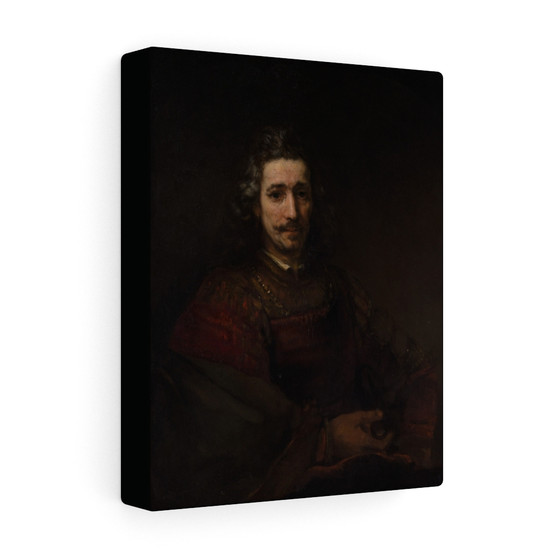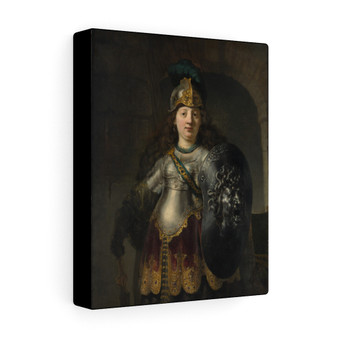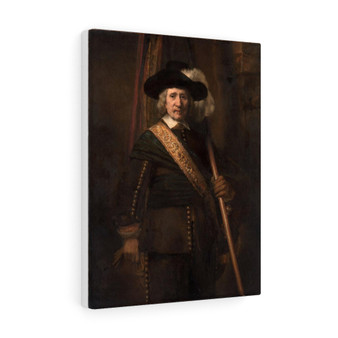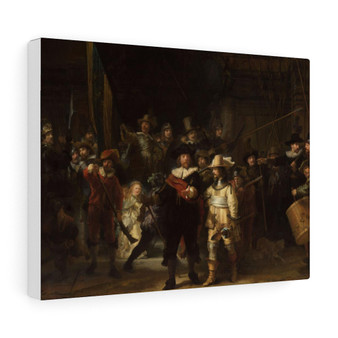Product Description
Man with a Magnifying Glass, early 1660s, Rembrandt (Rembrandt van Rijn), Dutch. Historical artwork in public domain. This portrait most likely depicts the Amsterdam auctioneer Pieter Haringh (1609–1685), who once handled the sale of a famous portrait by the Italian Renaissance master Raphael that served Rembrandt as a source of inspiration. The sitter may have used the magnifying glass in his hand to evaluate paintings and other luxury goods circulating on the busy Amsterdam art market. Like his wife in the pendant portrait also on view here, the sitter wears a form of fancy dress that has little to do with Dutch clothing worn at the time. Title: Man with a Magnifying Glass Artist: Rembrandt (Rembrandt van Rijn) (Dutch, Leiden 1606–1669 Amsterdam) Date: early 1660s Medium: Oil on canvas This portrait is the pendant to Woman with a Pink (14.40.622). The sitters have been variously identified as Harrings, son of the jailor of the Amsterdam debtors' prison, and his wife (d'Oultremont 1889); Titus van Rijn and Magdalena van Loo (Valentiner 1905); Baruch Spinoza (Goekoop-De Jongh 1915; Spinoza was, however, a bachelor); Jan Lutma the Younger and his wife (Lugt 1942); the couple who appears in the Family Group (Herzog Anton Ulrich-Museum, Braunschweig; see Michel 1894); and the couple who appears in the so-called "Jewish Bride" (Rijksmuseum, Amsterdam). Liedtke (1995) rejects all of these identifications but notes that the same sitters appear in pendant portraits of 1651 by Jan Victors (Steinberg collection, New York). References on the original Wilhelm [von] Bode. Studien zur Geschichte der holländischen Malerei. Braunschweig, 1883, pp. 531, 539, 560, no. 23, on the advice of Bredius, dates this painting and its pendant, "Woman with a Pink" (MMA 14.40.622), probably after 1660; in the catalogue, dates it about 1665; as in an exhibition in Brussels in 1882. Eugène Dutuit. Tableaux et dessins de Rembrandt. Paris, 1885, pp. 50, 63, 70, no. 347, repeats Bode's dating [see Ref. 1883] of about 1665. Alfred von Wurzbach. Rembrandt-galerie. Stuttgart, 1886, text vol., no. 6. Catalogue de douze tableaux . . . provenant de la collection d'Oultremont. Hôtel Drouot, Paris. June 27, 1889, pp. 5–6, 15–16, no. 7, ill., identifies the sitter as Harrings, son of the jailor of the Amsterdam debtors' prison; comments that he is a military officer, judging from his costume. Emile Michel. Rembrandt: His Life, His Work, and His Time. English ed. New York, 1894, pp. 182–84, 239, dates it and MMA 14.40.622 about 1666–68 in text, and 1662–65 in catalogue; finds the sitters similar in appearance to the couple in the Family Group (Herzog Anton Ulrich-Museum, Braunschweig); notes that the male portrait is in the collection of Maurice Kann, and the female portrait in the collection of Rodolphe Kann. Illustrated Catalogue of 300 Paintings by Old Masters of the Dutch, Flemish, Italian, French, and English Schools. Paris, 1898, p. 174, no. 155, ill. p. 175. Gustav Glück. "Die Gemäldesammlung des Herrn Rudolf Kann in Paris." Die Graphischen Künste 23 (1900), p. 90. Wilhelm [von] Bode with the assistance of C. Hofstede de Groot. The Complete Work of Rembrandt. Vol. 7, Paris, 1902, pp. 26-27, 132, 134, no. 535, pl. 535, dates the pendants about 1662–65, despite similarities to pictures of the late 1660s. Auguste Marguillier. "La collection de M. Rodolphe Kann." Les arts 2 (February 1903), p. 22. Wilhelm R. Valentiner. Rembrandt und seine Umgebung. Strasbourg, 1905, p. 56, identifies the sitters as Rembrandt's son, Titus, and his wife, Magdalena van Loo, stating that they are also represented in the so-called "Jewish Bride" (Rijksmuseum, Amsterdam). Adolf Rosenberg. Rembrandt, des Meisters Gemälde. 2nd ed. Stuttgart, 1906, p. 405, ill. p. 373, dates it about 1662–65; disputes Valentiner's [see Ref. 1905] identification of the sitter as Titus. Adolf Rosenberg. Rembrandt, des Meisters Gemälde. Ed. W. R. Valentiner. 3rd ed. Stuttgart, 1909, p. 564, ill. p. 482, identifies the sitters as Titus van Rijn and his wife Magdalena, stating that Bode has agreed; based on this identification, states that the portraits cannot have been painted 1662–65, as Titus was married in 1668. Wilhelm R. Valentiner. The Hudson-Fulton Celebration: Catalogue of an Exhibition Held in The Metropolitan Museum of Art. Exh. cat., The Metropolitan Museum of Art. New York, 1909, vol. 1, p. 148, no. 107A, ill. opp. p. 148, as Titus; dates it about 1668. Joseph Breck. "L'art hollandais à l'exposition Hudson-Fulton à New York." L'art flamand & hollandais 13, no. 2 (1910), p. 53 [published in Dutch in Onze Kunst 17 (January 1910), p. 10]. E[mil]. Waldmann. "Die Ausstellung Holländischer Gemälde des 17. Jahrhunderts in New York." Zeitschrift für bildende Kunst, n.s., 21, no. 4 (1910), pp. 75–76. "The Benjamin Altman Bequest." Metropolitan Museum of Art Bulletin 8 (November 1913), p. 236, ill. p. 234. Handbook of the Benjamin Altman Collection. New York, 1914, pp. 9–10, no. 4, ill. opp. p. 8, as Titus van Rijn, painted just after 1668; states that he is holding a ring, not a magnifying glass, and notes that Rembrandt often depicted his sitters as older than they actually were. Wilhelm R. Valentiner. "The Rembrandts of the Altman Collection: II." Art in America 2 (October 1914), pp. 395–96, fig. 2, as probably dating from the summer of 1668; states that Titus holds a ring. J. Goekoop-De Jongh. "De Man met het Vergrootglas, door Rembrandt." Feest-Bundel Dr. Abraham Bredius aangeboden den Achttienden April 1915. Vol. 1, 1915, pp. 53–60, identifies the sitter as Baruch Spinoza. C[ornelis]. Hofstede de Groot. A Catalogue Raisonné of the Works of the Most Eminent Dutch Painters of the Seventeenth Century. Ed. Edward G. Hawke. Vol. 6, London, 1916, pp. 354–55, 398, no. 755, as painted about 1662–65. Wilhelm R. Valentiner. Rembrandt wiedergefundene Gemälde. Stuttgart, 1921, p. 128, states that Goekoop-De Jongh's identification of the sitter as Spinoza [see Ref. 1915] is untenable because Spinoza was not married. François Monod. "La Galerie Altman au Metropolitan Museum de New-York (2e article)." Gazette des beaux-arts, 5th ser., 8 (November 1923), pp. 306–7, calls the pendants very late works, but questions whether they represent Titus and his wife, and whether they are therefore as late as Valentiner thinks [see Ref. 1914]. John C. van Dyke. Rembrandt and His School. New York, 1923, p. 41, calls this picture and its pendant "good shop portraits," stating that there is no reason to suppose that they portray Titus van Rijn and his wife. D. S. Meldrum. Rembrandt's Paintings. London, 1923, pp. 139, 203, pl. CCCCXXXIII, states that "the man is not Titus, even if Titus sat for it"; dates it about 1662–65. Alan Burroughs. "Rembrandts in the Metropolitan Museum." The Arts 4 (November 1923), p. 268, ill. p. 271. Werner Weisbach. Rembrandt. Berlin, 1926, pp. 545, 593. Max Eisler. Der alte Rembrandt. Vienna, 1927, pp. 103–6, dates the portraits about 1668 and states that the female sitter is not necessarily the "partner" of the man. Gustav Glück. "Rembrandts Selbstbildnis aus dem Jahre 1652." Jahrbuch der kunsthistorischen Sammlungen in Wien, n.s., 2 (1928), p. 317 [reprinted in Aus drei Jahrhunderten Europäischer Malerei, Vienna, 1933, p. 346]. Wilhelm R. Valentiner. Rembrandt Paintings in America. New York, 1931, unpaginated, no. 173, pl. 173, defends his identification of the sitter as Titus. A[braham]. Bredius. Rembrandt Gemälde. Vienna, 1935, p. 14, no. 326, pl. 326, rejects the identification of the sitters as Titus and Magdalena van Loo but thinks the same couple is represented in the "Jewish Bride". O[tto]. Benesch in Allgemeines Lexikon der bildenden Künstler. Ed. Hans Vollmer. Vol. 29, Leipzig, 1935, p. 267. Duveen Pictures in Public Collections of America. New York, 1941, unpaginated, no. 204, ill. William M. Ivins Jr. "The Art of Rembrandt." Metropolitan Museum of Art Bulletin 37 (January 1942), p. 3. Introduction by William M. Ivins Jr. The Unseen Rembrandt. New York, 1942, pls. 27–28 (overall and detail). Julius S. Held. "Rembrandt: The Self-Education of an Artist." Art News 40 (February 1–14, 1942), p. 28, ill. on cover (color detail). Frits Lugt. "Rembrandt's 'Man with the Magnifying Glass': A New Identification." Art in America 30 (July 1942), pp. 174, 177–78, figs. 1, 3 (detail), and ill. on cover, based on similarities with an engraved self-portrait, identifies the sitter as Jan Lutma the Younger. Josephine L. Allen. "The Museum's Rembrandts." Metropolitan Museum of Art Bulletin 4 (November 1945), p. 73. Franz Landsberger. Rembrandt, the Jews, and the Bible. Philadelphia, 1946, pp. 53–54, rejects the identification of the sitter as Spinoza, but notes that an identification of the sitter as Jan Lutma the Youger [see Ref. Lugt 1942] has been made "upon much better grounds". Jakob Rosenberg. Rembrandt. Cambridge, Mass., 1948, vol. 1, pp. 49, 203, 219 n. 10; vol. 2, pls. 75, 266 (detail). Theodore Rousseau Jr. "Rembrandt." Metropolitan Museum of Art Bulletin 11 (November 1952), p. 82. Josephine L. Allen and Elizabeth E. Gardner. A Concise Catalogue of the European Paintings in The Metropolitan Museum of Art. New York, 1954, p. 82. Margaretta M. Salinger. "Eight American Rembrandts." Connoisseur 138 (September 1956), p. 68, no. 2, ill. p. 70, discusses various identifications of the sitter, noting that Jan Lutma the Younger [see Ref. Lugt 1942] was never married; states that an identification of the sitters with those depicted in "The Jewish Bride" "seems cogent, though it attaches no names to the subjects". W. R. Valentiner. "Noch Einmal 'Die Judenbraut'." Festschrift Kurt Bauch. [Munich], 1957, pp. 230, 232–33, fig. 3, as Titus van Rijn and Magdalena van Loo. Jakob Rosenberg. Rembrandt: Life & Work. rev. ed. London, 1964, pp. 86, 322–23, figs. 75, 266 (detail). Jakob Rosenberg and Seymour Slive in Dutch Art and Architecture: 1600 to 1800. Baltimore, 1966, pp. 72, 270 n. 25. Kurt Bauch. Rembrandt Gemälde. Berlin, 1966, p. 23, pl. 447. Egbert Haverkamp-Begemann in Encyclopedia of World Art. Vol. 11, New York, 1966, col. 934. Horst Gerson. Rembrandt Paintings. Ed. Gary Schwartz. Amsterdam, 1968, pp. 452, 504, no. 417, ill. p. 453. Bob Haak. Rembrandt: His Life, His Work, His Time. New York, [1969], p. 326, fig. 547. Julius S. Held. Rembrandt's "Aristotle" and other Rembrandt Studies. Princeton, 1969, p. 9. Paolo Lecaldano in L'opera pittorica completa di Rembrandt. Milan, 1969, p. 124, no. 445, ill. Horst Gerson, ed. Rembrandt: The Complete Edition of the Paintings.. By A[braham]. Bredius. 3rd ed. London, 1969, pp. 575, 582, no. 326, ill. p. 254. Calvin Tomkins. Merchants and Masterpieces: The Story of The Metropolitan Museum of Art. New York, 1970, pp. 172–73 [rev., enl. ed., 1989]. Francis Haskell. "The Benjamin Altman Bequest." Metropolitan Museum Journal 3 (1970), pp. 266, 279, fig. 6. Jakob Rosenberg and Seymour Slive in Dutch Art and Architecture: 1600 to 1800. rev. ed. Harmondsworth, England, 1972, pp. 124, 433–34 n. 25. Julián Gállego and Frédéric Mégret. La grande histoire de la peinture. Vol. 10, Le Siècle d'or en Hollande. [Geneva], 1973, p. 22. Josua Bruyn in "Round-Table Discussion: Problems of Attribution." Rembrandt After Three Hundred Years. Chicago, 1973, p. 47. Christopher Brown. "Rembrandt's 'Portrait of a Boy'." Connoisseur 193 (November 1976), p. 219 n. 4, states that the identification of the sitters as Titus van Rijn and Magdalena van Loo "has not found any support". John Walsh Jr. "Child's Play in Rembrandt's 'A Lady and Gentleman in Black'." Fenway Court (1976), p. 6. J. Bolten and H. Bolten-Rempt. The Hidden Rembrandt. Milan, 1977, p. 203, no. 568, ill. Howard Hibbard. The Metropolitan Museum of Art. New York, 1980, p. 344. Maryan W. Ainsworth et al. Art and Autoradiography: Insights into the Genesis of Paintings by Rembrandt, Van Dyck, and Vermeer. New York, 1982, pp. 77, 82, 99 n. 57, pp. 100, 102, pls. 51–54 (overall, radiograph, and autoradiographs). Werner Sumowski. Gemälde der Rembrandt-Schüler. Vol. 4, Ch. Paudiss–Anonyme. Landau/Pfalz, 1983–[94?], p. 2617, under no. 1814. Werner Sumowski. Gemälde der Rembrandt-Schüler. Vol. 5, Nachträge Ortsregister. Landau/Pfalz, 1983–[94?], p. 3367. Rüdiger Klessmann. Die holländischen Gemälde. Braunschweig, 1983, p. 169, under no. 238. Gary Schwartz. Rembrandt, His Life, His Paintings. New York, 1985, p. 343, fig. 403 (color). Peter C. Sutton. A Guide to Dutch Art in America. Grand Rapids, Mich., 1986, p. 185. Christian Tümpel. Rembrandt: Mythos und Methode. Königstein, 1986, p. 414, no. 223, ill. p. 330 (color). Svetlana [L.] Alpers. Rembrandt's Enterprise: The Studio and the Market. Chicago, 1988, p. 85, fig. 3.65. Walter Liedtke. "Dutch Paintings in America: The Collectors and Their Ideals." Great Dutch Paintings from America. Exh. cat., Mauritshuis, The Hague. Zwolle, The Netherlands, 1990, p. 48, fig. 36 (Altman gallery installation). David R. Smith. "Review of H. Perry Chapman, "Rembrandt's Self-Portraits"." Art Bulletin 72 (December 1990), p. 664. Pierre Cabanne. Rembrandt. [Paris], 1991, p. 153, no. 22, ill. Leonard J. Slatkes. Rembrandt: Catalogo completo dei dipinti. Florence, 1992, pp. 236–37, no. 144, ill. (color). Jaap van der Veen in De Wereld Binnen Handbereik: Nederlandse Kunst- en Rariteitenverzamelingen. Ed. Ellinoor Bergvelt and Renée Kistemaker. Exh. cat., Amsterdams Historisch Museum. Vol. 1, "Essaybundel."Zwolle, The Netherlands, 1992, p. 247, fig. 13. Walter Liedtke in Rembrandt/Not Rembrandt in The Metropolitan Museum of Art: Aspects of Connoisseurship. Exh. cat., The Metropolitan Museum of Art. Vol. 2, "Paintings, Drawings, and Prints: Art-Historical Perspectives."New York, [1995], pp. 81–86, 115–16, no. 17, ill. (color and black and white), dates the portraits about 1662, and identifies the sitters with a couple painted by Jan Victors in 1651 (Steinberg collection, New York). Seymour Slive. Dutch Painting 1600–1800. New Haven, 1995, pp. 87, 332 n. 31, fig. 107. Arthur K. Wheelock Jr. Dutch Paintings of the Seventeenth Century. Washington, 1995, p. 278 n. 1. Hubert von Sonnenburg. Rembrandt/Not Rembrandt in The Metropolitan Museum of Art: Aspects of Connoisseurship. Exh. cat., The Metropolitan Museum of Art. Vol. 1, "Paintings: Problems and Issues."New York, 1995, pp. 16, 24–25, 31, 54, 58, 69–70, 79, figs. 10 (x-radiograph), 11 (autoradiograph), 70 (color detail), 71 (x-radiograph detail), 87, 88–90 (color details). J[osua]. Bruyn. "Werner Sumowski, 'Gemälde der Rembrandt-Schüler' IV en V." Oud Holland 109, no. 1/2 (1995), p. 105. Katharine Baetjer. European Paintings in The Metropolitan Museum of Art by Artists Born Before 1865: A Summary Catalogue. New York, 1995, p. 317, ill. B[en]. P. J. Broos in The Dictionary of Art. Ed. Jane Turner. Vol. 26, New York, 1996, p. 169. Paul Broekhoff and Michiel Franken. "Rembrandt/Not Rembrandt in The Metropolitan Museum of Art: Aspects of Connoisseurship." Simiolus 25, no. 1 (1997), p. 81. Christel Brückner. Rembrandt's Braunschweiger "Familienbild". Hildesheim, 1997, p. 12 n. 9, pp. 52–53. Christopher Wright. Rembrandt. Paris, 2000, p. 234, fig. 227 (color). Stephanie S. Dickey. "Rembrandt and Saskia: Art, Commerce, and the Poetics of Portraiture." Rethinking Rembrandt. Ed. Alan Chong and Michael Zell. Boston, 2002, p. 213 n. 43. Meryle Secrest. Duveen: A Life in Art. New York, 2004, p. 477. Catherine B. Scallen. Rembrandt, Reputation, and the Practice of Connoisseurship. Amsterdam, 2004, p. 363 n. 99. Esmée Quodbach. "The Age of Rembrandt: Dutch Paintings in The Metropolitan Museum of Art." Metropolitan Museum of Art Bulletin 65 (Summer 2007), pp. 31–33, 35, 38, 70, figs. 32 (Altman gallery photograph), 40 (color, MMA Altman gallery photograph). Walter Liedtke. Dutch Paintings in The Metropolitan Museum of Art. New York, 2007, vol. 1, p. ix; vol. 2, pp. 549, 693–705, 754, 776, 910, no. 158, colorpl. 158, figs. 192, 197 (sixth autoradiograph), 199 (detail), calls the pendants "completely consistent with Rembrandt's work in the first half of the 1660s". Dagmar Hirschfelder. Tronie und Porträt in der niederländischen Malerei des 17. Jahrhunderts. Berlin, 2008, pp. 127, 270, 289, 424, no. 459, fig. 17, pl. 98, dates the pendants about 1662. Walter Liedtke. "Rembrandt Revelations at the Metropolitan Museum." Jahrbuch der Berliner Museen, Beiheft: Wissenschaft auf der Suche 51 (2009), pp. 43, 47–48, figs. 5, 7 (overall and detail). Marjorie E. Wieseman. "Rembrandt's Portrait(s?) of Frederik Rihel." National Gallery Technical Bulletin 31 (2010), pp. 99, 110 n. 11. George S. Keyes in Rembrandt in America: Collecting and Connoisseurship. Exh. cat., North Carolina Museum of Art. New York, 2011, pp. 73–74, 84 n. 41, pp. 134–35, 139 n. 19, fig. 36 (color). Marco M. Mascolo. "Benjamin Altman’s Loans to the 1909 Hudson-Fulton Exhibition at The Metropolitan Museum of Art." Burlington Magazine 160 (April 2018), pp. 306–10, fig. 2 (color). Designed for indoor use, custom stretched canvas prints are made from treated cotton - providing the smoothest of matte surfaces for exceptional design vividity. A combination of quality and durability, these hangings come with a lifelong color guarantee; there's significant confidence in their withstanding the test of time. On the backside, pre-installed hanging hardware ensures proper locking to walls.
.: 100% cotton fabric
.: Wooden frame
.: High image quality and detail
.: For indoor use














